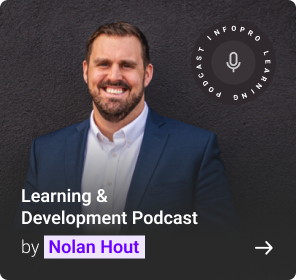Over the last two years, the lines between in-person and online training have blurred as most corporations have shifted toward remote-first culture. The word ‘hybrid’ is gaining more popularity each day and is ready to adopt changes that will define the future of the workforce and the workplace. The hybrid or blended learning model is not new for learning and development teams across various verticals. It has served as one of the essential frameworks that can aid businesses to strive and thrive.
The LinkedIn 2023 Workplace Learning Report says that the most important things for companies to focus on this year are: making sure that what employees learn at work helps the business succeed, helping employees learn new skills, encouraging a work environment where learning is valued, and finding ways to keep employees happy so they stay with the company.
With a constant shift towards hybrid work culture, remote employees must engage, upskill, and reskill with effective eLearning programs. Employees equipped with the right skill set and mindset hold the potential to meet their customers’ needs and accomplish the desired goals. Blended learning has proved to be a cost-effective solution to cater to the changing priorities of L&D leaders.
What is Blended Learning?
Blended learning, or hybrid learning, is an innovative instructional strategy that seamlessly blends traditional face-to-face teaching with online learning components. It encompasses integrating eLearning technologies, such as web-based modules, virtual classrooms, and interactive multimedia, with instructor-led sessions, workshops, and group discussions. The synergy between these diverse learning modes facilitates a comprehensive and engaging learning experience for employees.
The primary essence of blended learning lies in its flexibility. Using digital platforms, it allows employees to access training materials and resources at their own pace, anytime and anywhere. At the same time, it ensures valuable face-to-face interactions with instructors and peers during in-person sessions, fostering collaboration, teamwork, and deeper engagement with the subject matter.
The 70:20:10 framework is the most effective blended learning model to help with upskilling and reskilling. It suggests that learners gain knowledge and relevant skills through a blend of on-the-job, social, and formal learning.
What Is the Purpose of Blended Learning?
Blended learning allows learners of various abilities to advance their training at a pace that suits them best. It allows quick learners to progress at an accelerated rate while providing struggling learners the flexibility to learn at their speed and receive personalized support when facing challenges. In contrast, traditional classroom settings often restrict learners to a uniform level and pace of instruction, resulting in fast learners becoming disengaged and those needing additional assistance falling behind. The scalability of blended learning ensures the effectiveness of instruction at every stage, thereby positioning all learners for success as they acquire the essential skills required to excel in their job roles.
Do you know why blended learning is the most effective corporate training approach for employee upskilling and reskilling? Here are the two main reasons:
- The Changing Corporate Landscape Over the last few years, the economic disruption has significantly impacted business growth. Many organizations faced challenges such as managing remote workforce engagement, increasing service demand at remote locations, and more. Owing to this situation, employees had to upskill/reskill themselves through online learning to remain motivated and connected.Blended learning came to the rescue for the demotivated workforce as virtual instructor-led sessions help drive employee engagement. Short chunks of videos help inspire employees to retain knowledge and perform better. In addition, relevant course recommendations from trainers and managers create a sense of involvement, making employees more engaged and productive. Technavio predicts that the corporate blended learning market will experience a compound annual growth rate (CAGR) of 12.68% from 2022 to 2027, resulting in a significant market expansion of approximately USD 36,284.86 million.
- The Passion of Gen Z Learners to Unlock More Today, Gen Z learners contribute toward a major part of the workforce, which has grown around technological innovations. They get influenced by advanced digital technologies and leverage them to unlock their potential. Gen Z learners have a constant zeal to learn, engage, and upskill to grow and succeed in their career paths.Blended learning is an effective eLearning solution that enables Gen Z learners to access training content at their own pace and convenience. The vILT approach helps boost learner engagement and retention for improved training efficacy. Also, delivering short micro-lessons ensures just-in-time learning to reinforce knowledge and unlock workforce performance.
What Are the Different Types of Blended Learning?
According to Elucidat’s comprehensive Training Trends Report for 2022, approximately 30% of businesses opt to resume face-to-face training while simultaneously providing learners with alternative options. To adapt to the diverse needs of the evolving learning environment, blended learning design is undergoing updates.
There are various types of blended learning models, each with unique characteristics. The choice of model depends on various factors, including the institution’s goals, the learners’ needs, available resources, and the level of technological infrastructure. These are:
- Rotation Model: Learners rotate between different learning stations or modalities, including face-to-face instruction, online learning, small group activities, and individual assignments. For example, learners may spend time in a physical classroom and switch to online activities or workstations. The rotation model allows individualized learning experiences, pacing, and flexibility of content delivery.
- Flex Model: Most of the learning takes place online, and learners have control over the time, place, and pace of their learning. They can access instructional materials and complete assignments remotely, often with the support of an on-site facilitator or instructor. The flex blended learning model allows personalized learning and accommodates diverse learner needs and schedules.
- Self-Blend Model: Learners are supplemented with traditional face-to-face classes with additional online courses or resources. For example, learners may take an online language course outside their regular school curriculum. This model provides unique exploration and customization opportunities based on learners’ interests and learning goals.
- Online Lab Model: Learners primarily engage in online learning but have access to a physical space, such as a computer lab or learning center, where they can receive instructor support or work collaboratively with peers. The online lab model combines the convenience of online learning with the benefits of in-person interaction and support.
- Flipped Classroom Model: This model reverses the traditional instruction sequence. Learners learn new concepts or content online through videos, readings, or interactive modules. They then come to the classroom to engage in discussions, projects, and activities that reinforce and apply what they have learned. This model allows for more active learning and fosters deeper understanding through collaborative work and direct interaction with the instructor.
- Enriched Virtual Model: Most learning occurs online, with learners attending periodic face-to-face sessions for additional support, collaborative projects, or hands-on activities. The online component provides flexibility and allows learners to progress at their own pace, while the in-person sessions offer social interaction and personalized guidance.
How Can Companies Get Started with Blended Learning?
To start with blended learning, companies can:
- Assess needs: Identify training requirements and performance gaps.
- Set goals: Define clear objectives aligned with organizational strategy.
- Choose delivery methods: Select a mix of online and offline modalities.
- Develop content: Create or curate engaging and relevant learning materials.
- Design learning paths: Map out structured sequences of activities and assessments.
- Implement an LMS: Use a learning management system for tracking content delivery.
- Provide support: Provide resources, mentoring, and technical assistance.
- Evaluate and iterate: Continuously assess the effectiveness and make improvements.
Final Thoughts
Moving ahead in 2023, every organization must opt for a blended learning approach to unlock their workforce potential and overall success. Blending traditional ILT strategy with other modalities such as social learning, online videos, and VR/AR makes learning more impactful, personalized, and accessible. For employees working from different locations and with different skills, blended learning can be an effective approach for L&D teams.




